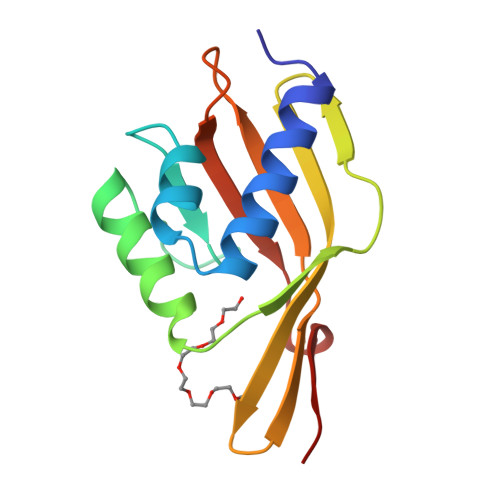Crystal structure and enzyme mechanism of Delta 5-3-ketosteroid isomerase from Pseudomonas testosteroni.
Cho, H.S., Choi, G., Choi, K.Y., Oh, B.H.(1998) Biochemistry 37: 8325-8330
- PubMed: 9622484
- DOI: https://doi.org/10.1021/bi9801614
- Primary Citation of Related Structures:
8CHO - PubMed Abstract:
Bacterial Delta 5-3-ketosteroid isomerase (KSI) from Pseudomonas testosteroni has been intensively studied as a prototype for understanding an enzyme-catalyzed allylic rearrangement involving intramolecular proton transfer. Asp38 serves as a general base to abstract the proton from the steroid C4-H, which is a much stronger base than the carboxyl group of this residue. This unfavorable proton transfer requires 11 kcal/mol of energy which has to be provided by favorable interactions between catalytic residues and substrate in the course of the catalytic reaction. How this energy is provided at the active site of KSI has been a controversial issue, and inevitably the enzyme mechanism is not settled. To resolve these issues, we have determined the crystal structure of this enzyme at 2.3 A resolution. The crystal structure revealed that the active site environment of P. testosteroni KSI is nearly identical to that of Pseudomonas putida KSI, whose structure in complex with a reaction intermediate analogue we have determined recently. Comparison of the two structures clearly indicates that the two KSIs should share the same enzyme mechanism involving the stabilization of the dienolate intermediate by the two direct hydrogen bonds to the dienolate oxyanion, one from Tyr14 OH and the other from Asp99 COOH. Mutational analysis of the two residues and other biochemical data strongly suggest that the hydrogen bond of Tyr14 provides the more significant contribution than that of Asp99 to the requisite 11 kcal/mol of energy for the catalytic power of KSI.
Organizational Affiliation:
Department of Life Science, School of Environmental Engineering, Pohang University of Science and Technology, Kyungbuk, South Korea.



















